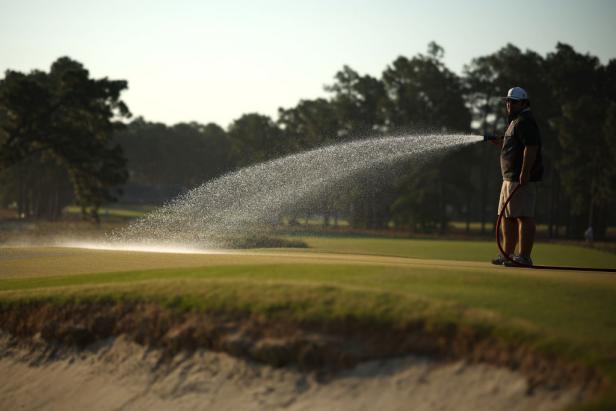Golf
U.S. Open 2024: How fast are the greens at Pinehurst?

PINEHURST, N.C. — How fast are the greens at the 2024 U.S. Open, you ask? If that’s the question you typed into Google and found yourself here, then congratulations. You’ve come to the right place.
If you’re looking for an exact number and nothing more, that green speed number is 14. Have a nice day.
But if you want to be a smart golf fan who fully appreciates what that green speed number means, and why it matters as we watch the weekend at the U.S. Open, here’s a quick rundown.
Golf courses measure green speeds using a Stimpmeter, which is a ramp-style device. You roll a golf ball down it in one direction, measure how far it rolls, then repeat the same process in the exact opposite direction and average the two numbers together to get a total number. That’s how the USGA got to 14.
He’s a fun video about it
Green speeds get faster throughout the day the firmer and drier they get. So they may start the day as a 14, but end the day at a 15 or more.
Pinehurst has an interesting wrinkle, though. The greens here are made of Bermuda grass, which grows quicker than other types of grass golf courses use. The more the grass grows, the slower the green speeds get. Yesterday, Pinehurst’s greens started at a 14 and ended closer to a 13.
They’ll probably start a little faster today, but it’s hard to predict what speed a green will end the day at. It all depends on a combination of weather factors.
You may have seen some pictures and videos of the USGA watering greens. Water helps the grass grow and softens the surface, which slows down the green speeds. So why would the USGA do that?
The answer is because the USGA is selectively hand-watering and rolling specific greens based on their needs. Their ultimate goal is to get consistency from green to green. They don’t want one to be green weirdly faster than the other, which means you need to treat each green according to its specific needs.
The faster the greens, the more the ball will roll on slopes (duh, obviously) which means the pin itself needs to be placed on flatter spots. If you put a pin on a slope too severe for the green speeds, the ball won’t stop rolling, and you’ll get an unplayable hole location.
At a speed around 14 on the Stimp Meter, you can’t really put a pin on a slope more than a three percent grade. The USGA did a good job on Saturday: Most of the pins are cut on relatively flat grades—rarely anything more than a 2.5% slope—but they’re surrounded by severe slopes. That’s what a good pin looks like, and hopefully we’ll see some drama because of it.










